 |
 |
|
Virtually every tourist who visits Ecuador will spend at least part of a day in Otavalo. Located about 2 hours north of Quito, Otavalo is home to Ecuador's most famous market.
It's a great place to buy all sorts of woven products, such as handmade cotton and wool sweaters, tapestry-like wall hangings, ponchos, vests, shigras (typical bags woven out of cabuya fibers), bracelets, bookmarks and many other items. |
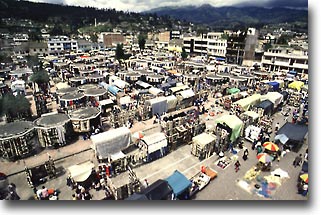 |
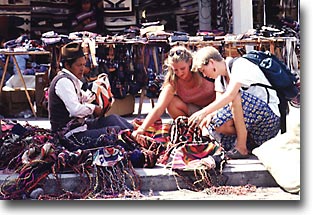
| I personally have seen them selling their products in Costa Rica and the U.S. More suprising to me was that much of what I saw in the shops in Cusco, Peru, was made in Otavalo, Ecuador. In reality, they travel to major cities all throughout the Americas, Europe, Asia and former Soviet-block countries. |
|
But, the best part about shopping in Otavalo is that the prices are more reasonable than you will find anywhere else.
The Otavalans expect that you will negociate a price. Generally you can expect to pay around 75% of the intial asking price, depending on your ability to negociate. Often tourists look at the Otavalan's clothing and are fooled into thinking that they are taking advantage of poor indians by offering too low of price. |
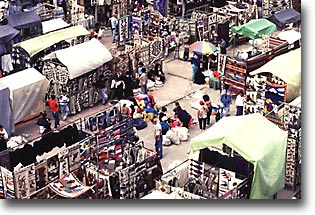 |
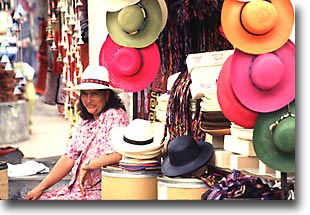
|
Don't be. Otavalans have kept their dress as they take great pride in their cultural history. Virtually all of the women and most of the older men retain their traditional dress. The younger generation of men tend to wear tennis shoes and sweatshirts.
The true sign of whether a man or woman is Otavalan is whether they keep the traditional long braid of hair. (The Saraguran men also have long braids, but they are almost always seen wearing blue knee-length shorts) |
|
The Otavalans are very smart businessmen and since they deal with tourists on a daily basis, they are very good at judging how much you are willing to pay for an item.
The other advantage they have over you is that they are multi-lingual. They speak Quichua, Spanish, some English and a few can understand far more French and German than they will admit. But, even if you paid the asking price, you'd still be getting a great deal. |
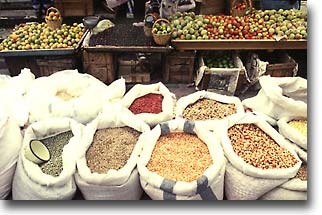 |
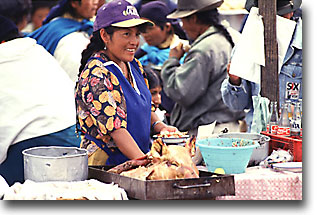 |
I'm not a real lover of shopping, so I go to my favorite spot on the square, the Pie Shop. I highly recomend the mora pie (blackberry/raspberry), slightly heated, with vanilla ice cream.
Otavalo is a great place to photograph people as long as it's an overcast day. Realize that Otavalans and other indigenous groups are not all that fond of having their pictures taken. You can ask to take their picture, and while they'll often agree, they usually stand at attention, get a real stiff expression and mostly look away from the camera. |
|
I haven't had real good results asking people to pose. I'm not proposing that you walk up and sneak a picture though. In reality, they will probably catch you in the act and yell a few words. You are very unlikely to get satisfactory results and it tends to make them more unfriendly to photographers. I've found the only way I can make them look good is if they don't know I'm taking a picture of them. This technique requires a long lens and a lot of patience. Equipment-wise I've used everything from a 80-200mm zoom to a 300mm lens with a 2x converter. The obvious problem with a long lens is that there are a lot of objects between you and your subject. I try to find a slightly elevated shooting position and some place out of the traffic flow to work from. |
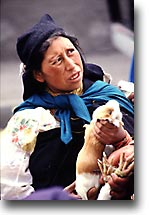 |
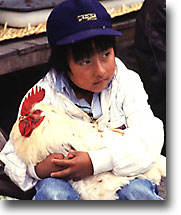 |
You can get good shots with a 80-200 as long as the subject is distracted by something else. The best results for me tend to happen while they are chatting with a friend or conducting business. I will sometimes stand in an out-of-the-way place until everyone simply ignores me. I try to get a couple of shots and move on before the subject ever realizes I got something on film.
Once in a great while a subject will catch me and either smile or turn away. A shaking finger means no pictures and should be respected.
Saturday is the biggest market day of the week in Otavalo. Not only do most of the tourist buses come but it's the local market day as well. At the north end of the tourist market is a small fruit and vegetable market. But you can usually find people selling cuys (guinea pigs), chickens, turkeys and rabbits as well. Larger animals such as cows, pigs, sheep and goats are sold at a lot along the highway on the west side of town, near the overpass crosswalk.
|
|
Heading south from the tourist market on Saturday will take you by an amazing assortment of goods and product demonstrations. It's awfully crowded though and you are opening yourself to the possibility to be "pick-pocketed".
The tourist market area itself is very, very safe. Otavalo realizes that pick-pockets are bad for business. So the vendors and police run anybody off who looks like trouble.
The non-tourist markets are safer than markets in Quito, but petty theft does happen. Do yourself a favor and leave your wallets at home. Any would-be-thief will find it hard to pass up a shot at an unsuspecting gringo with a 2 inch thick wallet. |
 |
 |
I really think it's best if you can have build some sort of relationship with the subject. In the case of these two school kids, I bought some firecrackers which we then set off underneath several vendors tables just to see how far they would jump.
In hindsight, this probably was not the best thing to teach them, but Ecuadorians love a good practical joke, and everyone smiled afterwards. |
|
The surrounding areas of Otavalo offer many photographic opportunies.
I like the picturesque patchwork field landscapes. Each spot seems to have a different best time to photograph it. The landscape is such that certain areas are completely in the shade long before other nearby sections. I personally prefer a partly sunny, partly cloudy sky for more dramatic lighting. I also like the added contrast to the scene. |
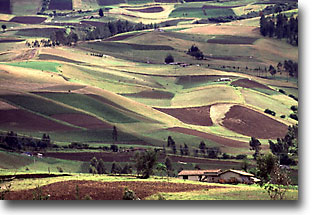 |
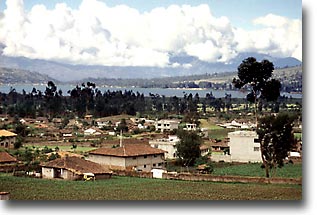 |
The Otavalo area has many other places to visit that I will feature at a later date. Most tours will take you to Cotocachi to shop for leather goods and San Antonio de Ibarra for carved wood objects.
There are several old haciendas and numerous craftsmen and weavers workshops that are worthwhile visiting as well. My favorites are natural wonders such as the volcanic crater lakes at Mojanda and Cuicocha as well as thousands of pre-columbian mounds, terraces, and pyramids. |
|
San Pablo is a rather large lake located just before Otavalo. There are a number of places to eat and stay around the lake.
I can personaly recomend Puerto Lago as being a really very nice hotel, their food is excellent as well. At around $50 a night, it's not for the budget traveler, but well worth the money. I think it has the best view, especially at dusk, when the volcano Imbabura looms above the lake. |
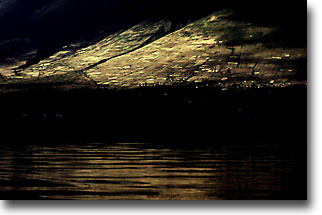 |
 |
Puerto Lago is also a good spot to photograph a few of the lake's reed harvesters.
For food, I highly reccomend anything at hotel Ali Shungu in Otavalo and especially the mora pie at the Pie Shop. Best of all, Otavalo has an established tourism infrastructure that makes it easy to get around to nature reserves and other activities to the north. Whether for week or just part of a day, Otavalo is a must for anyone visiting Ecuador. |